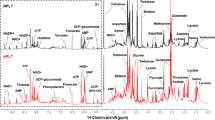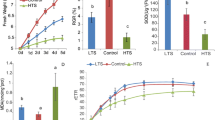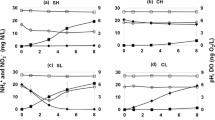Abstract
The most wide-spread “hostile” environmental factor for marine microorganisms is low temperature, which is usually accompanied by high hydrostatic pressure (HHP). Metabolic mechanisms of marine microorganisms adapting to prolonged low temperature under HHP remain to be clarified. To reveal the underlying metabolic mechanisms, we performed NMR-based metabolomic analysis of aqueous extracts derived from a psychrotolerant Microbacterium sediminis YLB-01, which was isolated from deep-sea sediment and possess great biotechnology potentials. The YLB-01 cells were firstly cultivated at the optimal condition (28 °C, 0.1 MPa) for either 18 h (logarithmic phase) or 24 h (stationary phase), then continually cultivated at either 28 °C or 4 °C under HHP (30 MPa) for 7 days. The cells cultivated at low temperature, which experienced cold stress, were distinctly distinguished from those at normal temperature. Cold stress primarily induced metabolic changes in amino acid metabolism and carbohydrate metabolism. Furthermore, the logarithmic and stationary phase cells cultivated at low temperature exhibited distinct metabolic discrimination, which was mostly reflected in the significantly disturbed carbohydrate metabolism. The logarithmic phase cells displayed suppressed TCA cycle, while the stationary phase cells showed decreased pyruvate and increased lactate. In addition, we performed transcriptome analysis for the stationary phase cells to support the metabolomic analysis. Our results suggest that the cold adaptation of the psychrotroph YLB-01 is closely associated with profoundly altered amino acid metabolism and carbohydrate metabolism. Our work provides a mechanistic understanding of the metabolic adaptation of marine psychrotrophs to prolonged low temperature under HHP.





Similar content being viewed by others
References
Abdi H (2010) Partial least squares regression and projection on latent structure regression (PLS regression). Wiley Interdiscip Rev Comput Stat 2:97–106
Angelidis AS, Smith GM (2003) Role of the glycine betaine and carnitine transporters in adaptation of Listeria monocytogenes to chill stress in defined medium. Appl Environ Microbiol 69:7492–7498
Beales N (2004) Adaptation of microorganisms to cold temperatures, weak acid preservatives, low pH, and osmotic stress: a review. Compr Rev Food Sci Food Saf 3:1–20. https://doi.org/10.1111/j.1541-4337.2004.tb00057.x
Beckonert O, Keun HC, Ebbels TMD, Bundy JG, Holmes E, Lindon JC, Nicholson JK (2007) Metabolic profiling, metabolomic and metabonomic procedures for NMR spectroscopy of urine, plasma, serum and tissue extracts. Nat Protoc 2:2692–2703. https://doi.org/10.1038/nprot.2007.376
Boucherie H (1985) Protein synthesis during transition and stationary phases under glucose limitation in Saccharomyces cerevisiae. J Bacteriol 161:385–392
Capece MC, Clark E, Saleh JK, Halford D, Heinl N, Hoskins S, Rothschild LJ (2013) Polyextremophiles and the constraints for terrestrial habitability. In: Seckbach J, Oren A, Stan-Lotter H (eds) Polyextremophiles: life under multiple forms of stress. Springer, Netherlands, pp 3–59
Casanueva A, Tuffin M, Cary C, Cowan DA (2010) Molecular adaptations to psychrophily: the impact of ‘omic’ technologies. Trends Microbiol 18:374–381. https://doi.org/10.1016/j.tim.2010.05.002
Cavicchioli R, Siddiqui KS, Andrews D, Sowers KR (2002) Low-temperature extremophiles and their applications. Curr Opin Biotechnol 13:253–261. https://doi.org/10.1016/s0958-1669(02)00317-8
Chintalapati S, Kiran MD, Shivaji S (2004) Role of membrane lipid fatty acids in cold adaptation. Cell Mol Biol 50:631–642
Cloarec O, Dumas ME, Trygg J, Craig A, Barton RH, Lindon JC, Nicholson JK, Holmes E (2005) Evaluation of the orthogonal projection on latent structure model limitations caused by chemical shift variability and improved visualization of biomarker changes in 1H NMR spectroscopic metabonomic studies. Anal Chem 77:517–526. https://doi.org/10.1021/ac048803i
Collins T, Margesin R (2019) Psychrophilic lifestyles: mechanisms of adaptation and biotechnological tools. Appl Microbiol Biotechnol 103:2857–2871. https://doi.org/10.1007/s00253-019-09659-5
Cragg GM, Newman DJ (2013) Natural products: a continuing source of novel drug leads. Biochim Biophys Acta - Gen Subj 1830:3670–3695. https://doi.org/10.1016/j.bbagen.2013.02.008
De Maayer P, Anderson D, Cary C, Cowan DA (2014) Some like it cold: understanding the survival strategies of psychrophiles. EMBO Rep 15:508–517. https://doi.org/10.1002/embr.201338170
Deming JW (2002) Psychrophiles and polar regions. Curr Opin Microbiol 5:301–309
Gallimore W (2017) In: Badal S, Delgoda R (eds) Chapter 18 – marine metabolites: oceans of opportunity. Pharmacognosy. Academic Press, pp 377–400
García-Ríos E, Querol A, Guillamón JM (2016) iTRAQ-based proteome profiling of Saccharomyces cerevisiae and cryotolerant species S. uvarum and S. kudriavzevii during low-temperature wine fermentation. J Proteome 146:70–79
Giddings L-A, Newman DJ (2015) Bioactive compounds from marine extremophiles. Springer, Cham
Gilbert JA, Hill PJ, Dodd CE, Laybournparry J (2004) Demonstration of antifreeze protein activity in Antarctic lake bacteria. Microbiology 150:171–180
Grzymski JJ, Carter BJ, Delong EF, Feldman RA, Ghadiri A, Murray AE (2006) Comparative genomics of DNA fragments from six Antarctic marine planktonic bacteria. Appl Environ Microbiol 72:1532–1541
Herman PK (2002) Stationary phase in yeast. Curr Opin Microbiol 5:602–607. https://doi.org/10.1016/S1369-5274(02)00377-6
Iwahashi H, Fujii S, Obuchi K, Kaul SC, Sato A, Komatsu Y (1993) Hydrostatic pressure is like high temperature and oxidative stress in the damage it causes to yeast. FEMS Microbiol Lett 108:53–57. http://dx.doi.org/
Kamjam M, Sivalingam P, Deng Z, Hong K (2017) Deep sea actinomycetes and their secondary metabolites. Front Microbiol 8. https://doi.org/10.3389/fmicb.2017.00760
Liljeqvist M, Ossandon FJ, Gonzalez C, Rajan S, Stell A, Valdes J, Holmes DS, Dopson M (2015) Metagenomic analysis reveals adaptations to a cold-adapted lifestyle in a low-temperature acid mine drainage stream. FEMS Microbiol Ecol 91. https://doi.org/10.1093/femsec/fiv011
Liu D, Lin H, Proksch P, Tang X, Shao Z, Lin W (2015) Microbacterins A and B, new peptaibols from the deep sea actinomycete Microbacterium sediminis sp. nov. YLB-01(T). Org Lett 17:1220–1223. https://doi.org/10.1021/acs.org.lett.5b00172
Longo VD, Gralla EB, Valentine JS (1996) Superoxide dismutase activity is essential for stationary phase survival in Saccharomyces cerevisiae. J Biol Chem 271:12275–12280
Lu H, Ulanov AV, Nobu M, Liu WT (2016) Global metabolomic responses of Nitrosomonas europaea 19718 to cold stress and altered ammonia feeding patterns. Appl Microbiol Biotechnol 100:1843–1852. https://doi.org/10.1007/s00253-015-7095-y
Manivasagan P, Venkatesan J, Sivakumar K, Kim S-K (2014) Pharmaceutically active secondary metabolites of marine actinobacteria. Microbiol Res 169:262–278. https://doi.org/10.1016/j.micres.2013.07.014
Margesin R, Miteva V (2011) Diversity and ecology of psychrophilic microorganisms. Res Microbiol 162:346–361. https://doi.org/10.1016/j.resmic.2010.12.004
Methe BA, Nelson KE, Deming JW, Momen B, Melamud E, Zhang X, Moult J, Madupu R, Nelson WC, Dodson RJ, Brinkac LM (2005) The psychrophilic lifestyle as revealed by the genome sequence of Colwellia psychrerythraea 34H through genomic and proteomic analyses. Proc Natl Acad Sci 102:10913–10918
Morita RY (1975) Psychrophilic Bacteria1. Bacteriol Rev 39:144–167
Morita RY, Moyer CL (2001) Psychrophiles. In: Encyclopedia of biodiversity, 2nd edn. Academic Press, Waltham, pp 298–303
Mykytczuk NCS, Foote SJ, Omelon CR, Southam G, Greer CW, Whyte LG (2013) Bacterial growth at −15 degrees C; molecular insights from the permafrost bacterium Planococcus halocryophilus Or1. ISME J 7:1211–1226. https://doi.org/10.1038/ismej.2013.8
Nguyen DV, Rocke DM (2002) Tumor classification by partial least squares using microarray gene expression data. Bioinformatics 18:39–50
Niu S, Zhou TT, Xie CL, Zhang GY, Yang XW (2017) Microindolinone A, a novel 4,5,6,7-tetrahydroindole, from the deep-sea-derived actinomycete Microbacterium sp. MCCC 1A11207. Mar Drugs 15:4–11. https://doi.org/10.3390/md15070230
Ramana KV, Singh L, Dhaked RK (2000) Biotechnological application of psychrophiles and their habitat to low-temperature. J Sci Ind Res 59:87–101
Rodrigues DF, Tiedje JM (2008) Coping with our cold planet. Appl Environ Microbiol 74:1677–1686. https://doi.org/10.1128/AEM.02000-07
Russell NJ, Harrisson P, Johnston IA, Jaenicke R, Zuber M, Franks F, Wynn-Williams D (1990) Cold adaptation of microorganisms. Philos Trans R Soc London 326:595–608 [and discussion]
Tchigvintsev A, Tran H, Popovic A, Kovacic F, Brown G, Flick R, Hajighasemi M, Egorova O, Somody JC, Tchigvintsev D, Khusnutdinova A, Chernikova TN, Golyshina OV, Yakimov MM, Savchenko A, Golyshin PN, Jaeger K-E, Yakunin AF (2015) The environment shapes microbial enzymes: five cold-active and salt-resistant carboxylesterases from marine metagenomes. Appl Microbiol Biotechnol 99:2165–2178. https://doi.org/10.1007/s00253-014-6038-3
Tribelli PM, Venero ECS, Ricardi MM, Gómez-Lozano M, Iustman LJR, Molin S, López NI (2015) Novel essential role of ethanol oxidation genes at low temperature revealed by transcriptome analysis in the antarctic bacterium Pseudomonas extremaustralis. PLoS One 10. https://doi.org/10.1371/journal.pone.0145353
Trygg J, Wold S (2002) Orthogonal projections to latent structures (O-PLS). J Chemom 16:119–128. https://doi.org/10.1002/cem.695
Trygg J, Holmes E, Lundstedt T (2007) Chemometrics in metabonomics. J Proteome Res 6:469–479
Tsuji M (2016) Cold-stress responses in the Antarctic basidiomycetous yeast Mrakia blollopis. R Soc Open Sci 3:160106. https://doi.org/10.1098/rsos.160106
Weber MH, Marahiel MA (2002) Coping with the cold: the cold shock response in the Gram-positive soil bacterium Bacillus subtilis. Philos Trans R Soc B Biol Sci 357:895–907
Wolf A, Krämer R, Morbach S (2003) Three pathways for trehalose metabolism in Corynebacterium glutamicum ATCC13032 and their significance in response to osmotic stress. Mol Microbiol 49:1119–1134
Xie C-L, Xia J-M, Wang J-S, Lin D-H, Yang X-W, Xie C-L, Xia J-M, Wang J-S, Lin D-H, Yang X-W (2018) Metabolomic investigations on Nesterenkonia flava revealed significant differences between marine and terrestrial actinomycetes. Mar Drugs 16:356. https://doi.org/10.3390/md16100356
Ye Y, Zhang L, Hao F, Zhang J, Wang Y, Tang H (2012) Global metabolomic responses of Escherichia coli to heat stress. J Proteome Res 11:2559–2566. https://doi.org/10.1021/pr3000128
Yu L, Lai Q, Yi Z, Zhang L, Huang Y, Gu L, Tang X (2013) Microbacterium sediminis sp. nov., a psychrotolerant, thermotolerant, halotolerant and alkalitolerant actinomycete isolated from deep-sea sediment. Int J Syst Evol Microbiol 63:25–30
Data availability statement
The metabolomic data reported in this article are available via [UCSD Metabolomics Workbench, http://www.metabolomicsworkbench.org/] study identifier [1285].
Funding
The work was funded by National Basic Research Program of China (No. 2015CB755901), the Xiamen Ocean Economic Innovation and Development Demonstration Project (No.16PZP001SF16), the Scientific Research Foundation of Third Institute of Oceanography, Ministry of Natural Resources (No. 2017035), and the National Natural Science Foundation of China (Nos. 41376172, 81661138005, 31971357).
Author information
Authors and Affiliations
Contributions
DHL, XXT, and CHH conceived and designed the research. JMX and DHL wrote the manuscript. XMH and JMX conducted the experiments and analyzed the data. LBY isolated the M. sediminis YLB-01 strain. RFX analyzed the transcriptomic data. All the authors have read and approved this manuscript.
Corresponding authors
Ethics declarations
This article does not contain any studies with human or animal subjects.
Conflict of interest
The authors declare that they have no competing interests.
Additional information
Publisher’s note
Springer Nature remains neutral with regard to jurisdictional claims in published maps and institutional affiliations.
Electronic supplementary material Please check if the ESM is presented correctly.The ESM is presented correctly.
ESM 1.
Specific growth rates of YLB-01 cells at 28 °C and 4 °C under different hydrostatic pressures (Fig. S1), the growth curve of the YLB-01 cells cultivated at 28 °C under 0.1 MPa (Fig. S2), multivariate analyses of 1H NMR spectra derived from the LT-L and NT-L cells (Fig. S3), and those from the HP-S and NP-S cells (Fig. S4), 1H NMR assignments of metabolites in aqueous extracts derived from the YLB-01 cells (Table S1), significant metabolites identified from the OPLS-DA analysis of LT-L cells vs. NT-L cells (Table S2). (PDF 645 kb)
Rights and permissions
About this article
Cite this article
Xia, JM., Hu, XM., Huang, CH. et al. Metabolic profiling of cold adaptation of a deep-sea psychrotolerant Microbacterium sediminis to prolonged low temperature under high hydrostatic pressure. Appl Microbiol Biotechnol 104, 277–289 (2020). https://doi.org/10.1007/s00253-019-10134-4
Received:
Revised:
Accepted:
Published:
Issue Date:
DOI: https://doi.org/10.1007/s00253-019-10134-4




